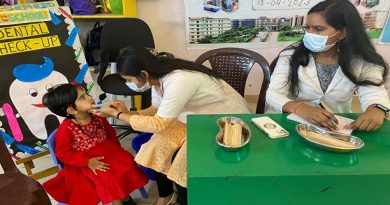Foot Care When You Have Diabetes
Dr. Vijay Singhal
In people with diabetes, a smaller blister, bug bite or footsore could lead to a difficult to heal foot infection, a skin ulcer, and even the possibility of amputation. With diabetes, lifetime risk factor for a foot ulcer is 25% & 9-20% of foot ulcers lead to amputation.
Causes
The exact cause of each type of diabetic neuropathy (nerve damage) is unknown. Researchers think that over time, uncontrolled high blood sugar damages nerves and interferes with their ability to send signals, leading to diabetic neuropathy. High blood sugar also weakens the walls of the small blood vessels (capillaries) that supply the nerves with oxygen and nutrients.
Risk factors-Anyone who has diabetes can develop neuropathy. But these risk factors make you more likely to get nerve damage:
Poor blood sugar control. Uncontrolled blood sugar puts you at risk of every diabetes complication, including nerve damage.
Diabetes history. Your risk of diabetic neuropathy increases the longer you have diabetes, especially if your blood sugar isn’t well controlled.
Kidney disease. Diabetes can damage the kidneys. Kidney damage sends toxins into the blood, which can lead to nerve damage.
Being overweight. Having a body mass index (BMI) of 25 or more may increase your risk of diabetic neuropathy. High blood pressure &high cholesterol also increase the risk of nerve damage.
Smoking. Smoking narrows and hardens your arteries, reducing blood flow to your legs and feet. This makes it more difficult for wounds to heal and damages the peripheral nerves.
Diabetes and Your Feet Care
If you have diabetes, check them every day, even if they feel fine and see your doctor if you have a cut or blister that won’t heal. When you check your feet every day, you can catch problems early and get them treated right away. Early treatment greatly reduces your risk of amputation.
There’s a lot to manage if you have diabetes: checking your blood sugar, making healthy food, finding time to be active, taking medicines, going to doctor’s appointments. With all that, your feet might be the last thing on your mind. But daily care is one of the best ways to prevent foot complications. You can have nerve damage in any part of your body, but nerves in your feet and legs are most often affected. Some people with nerve damage have numbness, tingling, or pain, but others have no symptoms. Nerve damage can also lower your ability to feel pain, heat, or cold. Living without pain sounds pretty good, but it comes at a high cost. Pain is the body’s way of telling you something’s wrong so you can take care of yourself. If you don’t feel pain in your feet, you may not notice a cut, blister, sore, or other problem. Small problems can become serious if they aren’t treated early.
Preventing Nerve Damage
Most important thing you can do to prevent nerve damage or stop it from getting worse is to keep your blood sugar level in the target range as much as possible.
Do not smoke. Smoking reduces the blood flow to the feet.
Follow a healthy eating plan. Include more fruits & vegetables & less of sugar & salt in your diet.
Get physically active. At least 30-40 minutes’ walk daily.
Take medicines as prescribed by your doctor.
Tips for Healthy Feet
Get to the bottom of any foot problems by using a mirror or asking
Check your feet every day for cuts, redness, swelling, sores, blisters, corns, calluses, ingrown toenails or any other change to the skin or nails. Use a mirror if you can’t see the bottom of your feet, or ask a family member to help. Check the temperature (feel hot or cold) & Colour (whether normal colour, pale, Red or blue) Check for any pain or swelling, Whether the skin is dry or cracked or if any rash is present.
Wash your feet every day in warm (not hot) water. Don’t soak your feet. Dry your feet completely and apply lotion to the top and bottom—but not between your toes, which could lead to infection.
Never go barefoot. Always wear shoes and socks or slippers, even inside, to avoid injury. Check that there aren’t any pebbles or other objects inside your shoes and that the lining is smooth.
Wear shoes that fit well. Skip the high heels, flip-flops and going barefoot (sockless). Comfortable, supportive shoes that fit well and with dry socks will help protect your feet from damage.
Go for comfort. Visit a shoe store where the staff will carefully measure your feet, such as a store that sells comfort shoes or athletic shoes. Have both feet measured and buy shoes that fit your larger foot. Leather and natural fibres are good choices. Wear shoes all the time except when you’re in bed or bathing.
Choose foot-friendly socks. Look for socks without seams (these can rub and cause skin breaks) and that isn’t tight. Change your socks once a day, more often if your feet get sweaty.
Trim your toenails straight across and gently smooth any sharp edges with a nail file. Have your foot doctor (podiatrist) trim your toenails if you can’t see or reach your feet.
Don’t remove corns or calluses yourself, and especially don’t use over-the-counter products to remove them—they could burn your skin.
Get your feet checked at every health care visit. Also, visit your foot doctor every year (more often if you have nerve damage) for a complete exam, which will include checking for feeling and blood flow in your feet.
Keep the blood flowing. Put your feet up when you’re sitting, and wiggle your toes for a few minutes several times throughout the day.
Choose feet-friendly activities like walking, riding a bike, or swimming. Check with your doctor about which activities are best for you and any you should avoid.
When to See Your Doctor
If you experience any of these symptoms, don’t wait for your next appointment. See your regular doctor or foot doctor right away:
- Pain in your legs or cramping in your buttocks, thighs, or calves during physical activity.
- Tingling, burning, or pain in your feet.
- Loss of sense of touch or ability to feel heat or cold very well.
- A change in the shape of your feet over time.
- Loss of hair on your toes, feet, and lower legs.
- Dry, cracked skin on your feet.
- A change in the colour and temperature of your feet.
- Fungus infections such as athlete’s foot between your toes.
- A blister, sore, ulcer, infected corn, or ingrown toenail.
Most people with diabetes can prevent serious foot complications. Regular care at home and going to all doctor’s appointments are your best bet for preventing foot problems (and stopping small problems from becoming serious ones).



